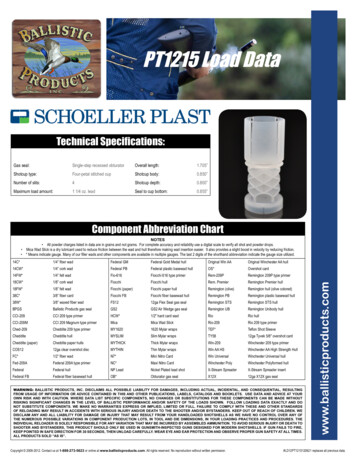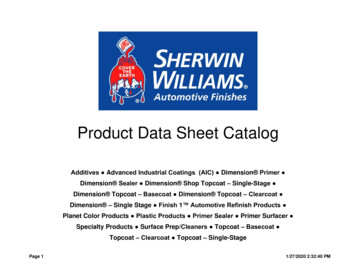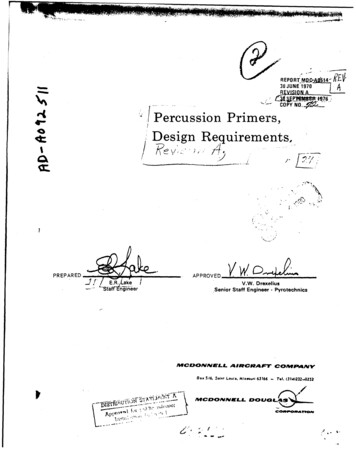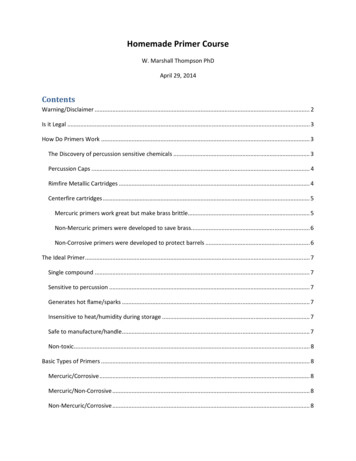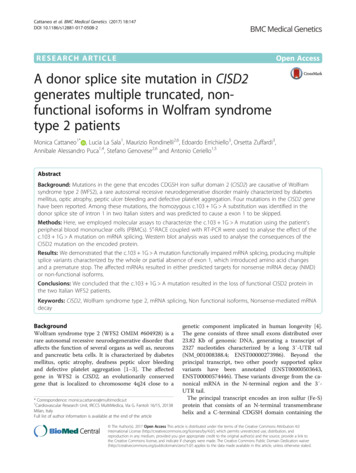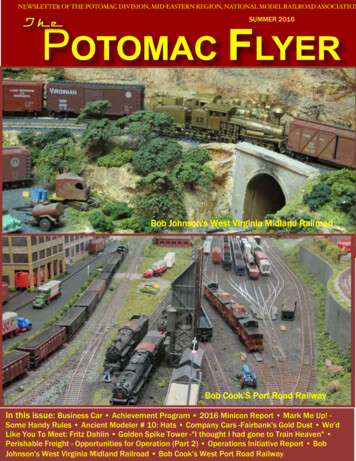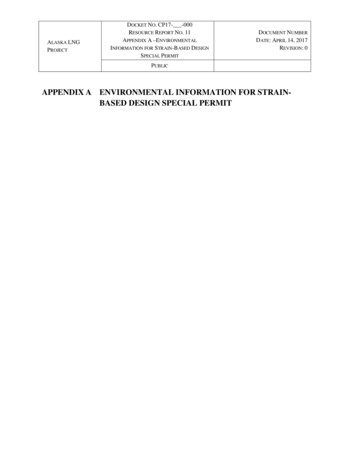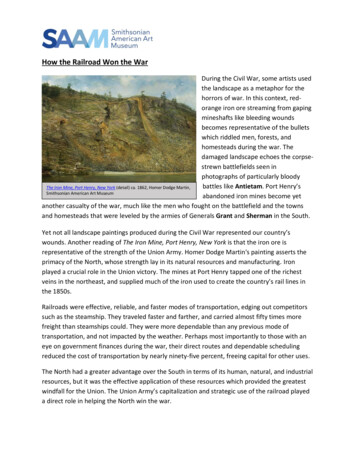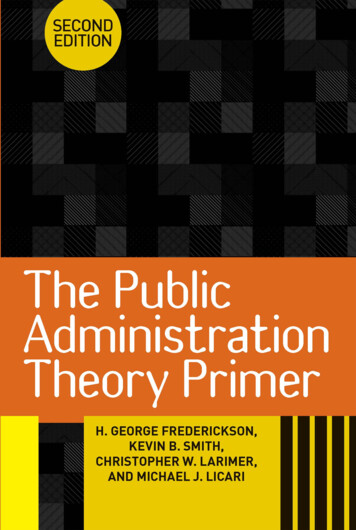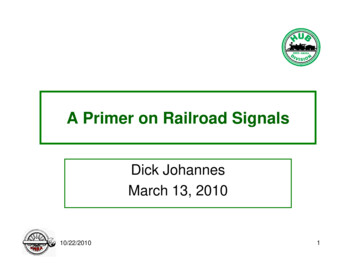
Transcription
A Primer on Railroad SignalsDick JohannesMarch 1313, 201010/22/20101
The variety of signalsseems endlessdl10/22/20102
Keyy historical events 1840: Ball signals:gLTC Rolt1841: Semaphore – Charles Gregory1851:Telegraph – Chas Minot1870: Track Circuit – William Robinson1871: Disk (Banjo) Signal – Thomas Hall1904: ColorClight signals – William ChurchillC1915: Position-light signals – Arthur Rudd1920: Searchlight Signals – Hall Signal CoCo.1924: Color Position signals – Frank Patenall1925: TriTri-colorcolor (G type) signals - GRS10/22/20103
Signals:g3 keyyqquestions1. What degree of prototypeaccuracy can do you want toachieve?2. What era and region are youmodeling?3. How much can yyou afford?10/22/20104
Two typesyp of “regions”gInterlockings & JunctionsBlock ABlock BBlock CBlock DBlock EBlock FBlock GLinear Blocks10/22/20105
The Distinctions Linear blocks––––Unsupervised (e.g. totally automated)Default is “clear” or “green”ABS (Automated Block Signaling)APS (Absolute Permissive Signaling) Interlockings (Junctions & Sidings)–––––Manually operated (e.g. human controlled)Default is “stop”p or “red”Mechanical interlocksUS&S panelsComputerized CTC10/22/20106
ABSTime 0Time 1Time 2Time 3Time 410/22/20107
ABS - weaknessTime 0Time 1Time 210/22/20108
APBDispatcher clears this train10/22/20109
The “OS” sectionDummyHeadDummyHead10/22/201010
AspectpCombinatoricsUPPER HEADLOWER HEADASPECTGREENGREEN281GREENYELLOWNot RED285REDGREEN283REDYELLOW290REDRED291
Aspects:pNORAC*10/22/2010Rule: 281Name: ClearIndication: Proceed notexceeding Normal SpeedRule: 281cName: Limited ClearIndication: Proceed at LimitedSpeed until entire train clearsall interlocking or springswitchesRule: 281aName: Cab SpeedIndication: Proceed inaccordance with cab signalindicationRule: 282Name: Approach MediumIndication: Proceedapproaching the next signal atMedium SpeedRule: 281bName: Approach LimitedIndication: Proceedapproaching the next signalat Limited SpeedRule: 282aName: Advance ApproachIndication: Proceed prepared tostop at the second signal.Trains exceeding Limited Speedmustt reducedtot LimitedLi it d SpeedSdas engine passed the signal* 9th Edition, 2008- Flashing12
Aspects:pNORAC* (cont)()Rule: 283Name: Medium-ClearIndication: Proceed at MediumSpeed until entire train clearsall interlocking or springswitches,stc es, tthene pproceedoceed atNormal SpeedRule: 285Name: ApproachIndication: Proceed prepared tostop at the next signal. Reduceto Medium Speed as enginepasses signalRule: 283aName: Medium ApproachMediumIndication: Proceed at MediumSpeed until entire train clearsall interlocking or springswitches, then approach nextsignal at Medium SpeedRule: 286Name: Medium ApproachIndication: Proceed ppreparedptostop at the next signal. Reduceto Medium Speed as soon assignal is clearly visibleRule: 287Name: Slow ClearIndication: Proceed at SlowSpeed until entire train clearsall interlocking or springswitches,it hthenth proceedd attNormal SpeedRule: 284Name: Approach SlowIndication: Proceedapproaching the next signalat Slow Speed10/22/2010* 9th Edition, 2008- Flashing13
Aspects:pNORAC* (cont)()Rule: 288Name: Slow ApproachIndication: Proceed at SlowSpeed until entire train clearsall interlocking or springswitches,stc es, tthene pproceedoceed atMedium SpeedRule: 292Name: Stop SignalIndication: StopRule: 290Name: RestrictingIndication: Proceed at RestrictedSpeed until entire train clears allinterlocking or spring switchesand leading wheels have 1)passed a more favorable signal or2) entered non-signaled territory.Rule: 296bName: Speed Limit SignIndication: Proceed at speedpposted on the Approach SpeedLimit Sign until entire train haspassed the Resume Speed SignRule: 291Name: Stop and ProceedIndication: Stop then proceed atRestricted Speed until leadingwheels have 1) passed a morefavorable signal or 2) enterednon-signaled territory10/22/2010* 9th Edition, 2008- FlashingSRRule: 296cName: Resume Speed SignIndication: Resume speed afterentire train has passed theResume Speed Sign14
The Modeler’s AspectspRule: 281Name: ClearIndication: Proceed notexceeding Normal SpeedRule: 285Name: ApproachIndication: Proceed prepared tostop at the next signal. Reduceto Medium Speed as enginepasses signal10/22/2010Rule: 292Name: Stop SignalIndication: StopRule: 290Name: RestrictingIndication: Proceed at RestrictedSpeed until entire train clears allinterlocking or spring switchesand leading wheels have 1)passed a more favorable signal or2) entered non-signaled territory.15
Create a linear schematic10/22/201016
Create a linear schematic10/22/201017
Create a linear schematicPortlandE. DeerfieldSpringfieldTo BostonTo SelkirkGardnerAyerWorcester Label blocks Label signals (Name east/west or north/south) What’s CTC and what’s block trackage between CTC10/22/201018
Three keyiimplementationlt ti questionsti What is the incoming information neededand how do I get it? How do I process the incomingi finformation?ti ? How do I output the processedinformation?10/22/201019
Inputsp Where are my trains?What direction are they moving?Wh t ttrainWhati iis it?How are my turnouts set?10/22/201020
DetectionIsolated fromTrack PowerReliabilityModification ofRolling StockCostR dSReedSwitchesit hYYesF iFairYYesHi TNoVery GoodYesMediumInductionYesVery GoodYesLowMethod10/22/201021
Processingg Hardware–––––Logic RailCustom Signals (Atlas)Integrated Signal SystemsCircuitronDallee Software––––JMRICMRIRailroad & CoSignals by Spreadsheet10/22/201022
Outputsp Strictly hardware– Gets complex and expensive with morecomplex track plans– Less flexible Hardware and Software– More flexible– RequiresRiprogrammingi ((somehow)h )10/22/201023
Controllingg the SystemyScreen shot fromDick Bronson’sHartford NationalClinics10/22/201024
CATS10/22/201025
Controllingg the SystemyLUSERVILLESHAFERS CROSSINGHAROLDTONENGLUND CENTRE10/22/201026
Controllingg the SystemyLUSERVILLESHAFERS CROSSINGHAROLDTONENGLUND CENTRE10/22/201027
Controllingg the SystemyLUSERVILLESHAFERS CROSSINGHAROLDTONENGLUND CENTRE10/22/201028
Controllingg the SystemyLUSERVILLESHAFERS CROSSINGHAROLDTONENGLUND CENTRE10/22/201029
The double saw-byyAspect?10/22/201030
Choices Ignore interlockings and just do ABS/APS Just do 1 or a few interlocks and ignorethe “blocks”blocks in between How long is a block?– 3 average train lengths?– 100 scale feet? How many aspects? Dark areas? How do you handle them?10/22/201031
Consider emulation Block or signal animators– Logic rail– Circuitron Just use Red/Green indications for R/Npositioniti att tturnoutst Will look pretty good and unless you areactually using them to operate may suffice10/22/201032
Appassingg sidingg6 detectors10 Signals16 signal heads to illuminate2 tortoises and DCC decoders10/22/2010 78 340 199 60 67733
The Future?C b SignalsCabSil Leg up for the modern modeler? NoNo fixed signals Location, direction & speed DCCDCC throttles with LCDs BiDirectional DCC Could stopp locomotive10/22/201034
References (Books)() Railroad Signaling. Brian Soloman, MBI Publishing 2003.How to operate your model railroad. Bruce A Chubb, 2nd Edition,Kalmbach, 1977.Realistic Model Railroad Operation.pTonyy Koester. Kalmbach 2003.The Model Railroaders Guide to Junctions. Jeff Wilson. Kalmbach2006.Railroader’sRailroaders Handbook Volume 2 Signaling SystemsSystems. Version 3 Dr.DrBruce A. Chubb. 2010 available through CMRI websiteRailroad Operation and Railway Signaling. Edmund J Phillips.Simmons-BoardmanSimmonsBoardman 1942Compendium of Signals. Roger F.R Karl. Boynton, 1971.All About Signals. John Armstrong, Kalmbach, 1967.10/22/201035
References ((Web Sites)) Carsten Lundstens site: http://www.lundsten.dk/us signaling/index.htmlNorac Simulator: ailroad Signals: http://www.railroadsignals.net/Railroad Signals of the US: http://www.railroadsignals.us/http://www railroadsignals us/JMRI: http://jmri.sourceforge.net/CATS: http://home.comcast.net/ kb0oys/CMRI http://www.jlcenterprises.net/CMRI:htt //jltit/Custom Signals: http://www.customsignals.com/ISS: http://www.integratedsignalsystems.com/Signals by Spreadsheet: http://www.signalsbyspreadsheet.com/Railroad Circuits: http://rr-cirkits.com/Logic Rail: http://www.logicrailtech.com/http://www logicrailtech com/10/22/201036
References (Journals)() Operating signals with software. Model Railroader, October 2007,page 50.50The Computer/Model Railroad Interface - A Case Study. ModelRailroading, December 1999/January 2000, page 32.Using State-of-the-art Electronics to Enhance Operation. NMRABulletin, March 2007 page 38.Signaling made easier (3 part article). Model Railroader, January2004, page 130.Automated Block Signaling using DCC Signal Driver Decoders. ModelRailroading, July 2006, page 28.Absolute-Permissive Block Signals (3 part article). Model Railroader,November 1991 page 128.Where to pplace trackside signalsgon a model railroad. ModelRailroader, October 2007, page 52.10/22/201037
THANK YOU10/22/201038
1904: Color light signals – William Churchill 1915: Position-light signals – Arthur Rudd . The Model Railroaders Guide to Junctions. Jeff Wilson. Kalmbach 2006. RailroaderRailroader s’s Handbook Volume 2 Signaling Systems Versio
